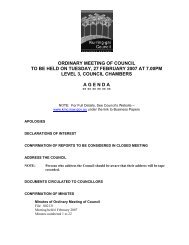Pymble Business Park - Ku-ring-gai Council
Pymble Business Park - Ku-ring-gai Council
Pymble Business Park - Ku-ring-gai Council
You also want an ePaper? Increase the reach of your titles
YUMPU automatically turns print PDFs into web optimized ePapers that Google loves.
13R.2 SUMMARY OF METHODOLOGY<br />
FOR CONVERSATION SIGNIFICANCE<br />
ASSESSMENT - GREENWEB (continued)<br />
13R<br />
Category 3<br />
This includes all vegetation of patch size ≥ 0.1ha in size or vegetation areas of good or moderate<br />
condition within the urban matrix.<br />
The patch size of ≥ 0.1ha, is estimated to include an area of approximately 6 large established trees.<br />
This patch size aligns to the 0.1ha layout of nested 20 × 50 m and 20 × 20 m plots used for the<br />
assessment of vegetation condition, as used within Biobanking (DECC 2008b) and the Biometrics<br />
methodology for assessing clea<strong>ring</strong> and ecological thinning proposals on terrestrial biodiversity under<br />
the Native Vegetation Act 2003 (DECCW 2011).<br />
This patch size is considerably larger than the ‘standard’ plot size (0.04ha) recommended by Native<br />
Vegetation Interim Type Standard for vegetation mapping and identifi cation (Sivertsen 2009 2 ).<br />
Note: A 5ha size threshold is adopted within the Biobanking methodology (DECC 2008a) and the<br />
BGHF listing advice under the EPBC Act (DEWHA 2005). A patch size analysis of Key Vegetation<br />
Communities<br />
≥ 0.1ha as included within Category 3, identifi ed that all patches ≥ 5ha are already mapped within<br />
Category 1 or 2.<br />
These areas assist in the maintenance of TECs across a range of topographies. They also play an<br />
important role as biodiversity reservoirs, providing stepping stone links for fauna and seedbank /<br />
pollination resources to support the survival of remnant vegetation patches.<br />
Small patches can be valuable for native inverterbrates and for some birds (Fischer and Lindenmayer,<br />
2002).Urban street trees for example, provide bird habitat for resting, nesting, feeding and hollow use<br />
(Young et al 2007, Tzilkowski et al 1986, Weleh 1994, Cannon 1999, Chamberlain et al 2004). They<br />
also provide habitat for pollinators, such as bats, that may be less constrained by landscape features<br />
(Aldrich & Hamrick 1998, cited in Sork and Smoise 2006).<br />
Areas included within this category (as well as those identifi ed within biodiversity and riparian corridors)<br />
provide genetic resources from remnant vegetation to support the ecological functions of both<br />
KVCs and non KVCs, and facilitate gene fl ow (reducing genetic erosion / isolation and the effects of<br />
fragmentation).<br />
In urban areas where fragmentation has occurred, the main strategy to fi ght genetic erosion is the<br />
maintenance of a good quality and quantity of gene fl ow among fragments. “Fragmentation does not<br />
necessarily equate to genetic isolation”, Krauss et al states (2007 p396). As long as there is suffi cient<br />
gene fl ow between fragments, species should be able to survive and grow at a distant site. In other<br />
words, even though habitat may be separated, if the quality and frequency of gene fl ow can be<br />
maintained, genetic erosion should not occur. Sork and Smoise (2006) summarized that two elements<br />
measu<strong>ring</strong> the degree of isolation of a fragmented landscape are the quantity of incoming pollen and<br />
the diversity of incoming gene sources.<br />
As such the more connectivity and protection of suffi cient / relevant remnant areas within the urban<br />
area, the higher level resilience or core areas will have.<br />
This category includes trees within KVCs identifi ed as signifi cant du<strong>ring</strong> <strong>Ku</strong>-<strong>ring</strong>-<strong>gai</strong> Key Vegetation<br />
Community mapping (KC 2011a and 2011b).<br />
REFERENCES<br />
This included the identifi cation of local native trees; identifi ed as signifi cant due to the presence of<br />
habitat (e.g. a hollow), provision of food for wildlife, and / or exceptional form or size. This mapping<br />
provides an opportunistic selection of signifi cant native trees and is not considered to capture every<br />
signifi cant tree within the urban landscape.<br />
1<br />
The Native Vegetation Interim Type Standard (Sivertsen 2009) addresses the quality and nature of the scientifi c<br />
processes for native vegetation type activities; and applies to all relevant vegetation activities to which the NSW<br />
Government is a signatory or to which the NSW Government makes a fi nancial or in-kind contribution.<br />
Draft <strong>Ku</strong>-<strong>ring</strong>-<strong>gai</strong> Local Centres Development Control Plan 2012<br />
p 191

















